Twenty-six years after first setting out harvesting beet on hire with a single-row Armer Salmon harvester, Kieran Crowley made the decision to move to a self-propelled machine this year.
Located in one of Ireland’s strongest beet growing regions, he had been playing with the idea for several years now. Growing corn and beet on the home farm, Kieran also runs a contracting business.
“I’ve been growing beet all my life. My father was at it before me too. We are currently harvesting 500 acres annually, with almost half of that being for ourselves. We are situated near Ballinadee, between Bandon and Kinsale in Co Cork. It’s estimated there is in the region of 1,000 acres of beet being grown in our parish alone,” he said. 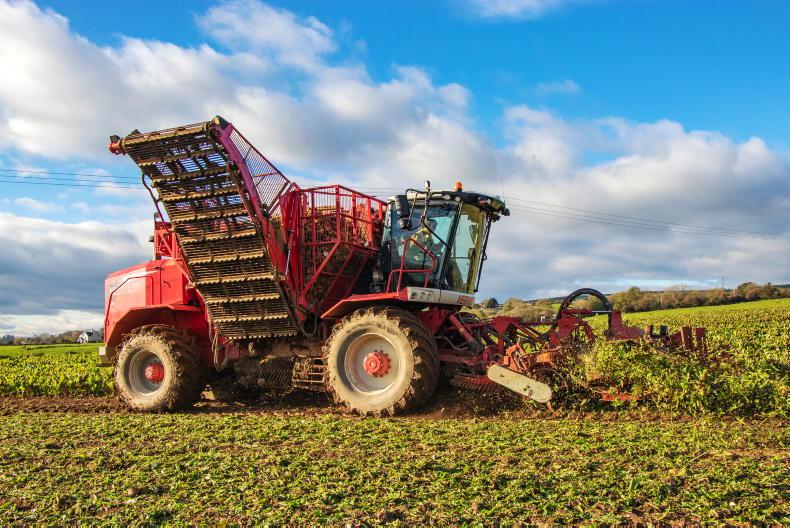
\ Gearoid Holland
Previous harvesters
Pre-1995, the Crowleys were growing 40 acres of beet annually for the then-vibrant sugar beet industry. This was being harvested with a single-row Armer Salmon harvester. In 1995, the family decided to offer beet harvesting on hire as part of their contracting operation, purchasing a fresh single-row Armer Salmon carousel-type harvester. Over the following decade, their harvesters were upgraded as the acres increased.
Kieran said: “When the beet factories closed in the mid 2000s, we were growing 100 acres annually ourselves and harvesting 350-400 acres on hire. All this was being harvested with a twin-row Armer Salmon machine. We thought the closure of the industry would break us. Our area harvested the following year dropped to just 70/80 acres. It was a massive hit at the time.
“Since then, the acres grown around us have increased steadily. Six or seven years ago we began washing the beet, and chopping it for some customers. This was a great boost and further increased our customer base which extends to a 50km radius. Last year, we harvested 400 acres, and are set to harvest 500 acres this year, all of which is grown within four miles of us.” 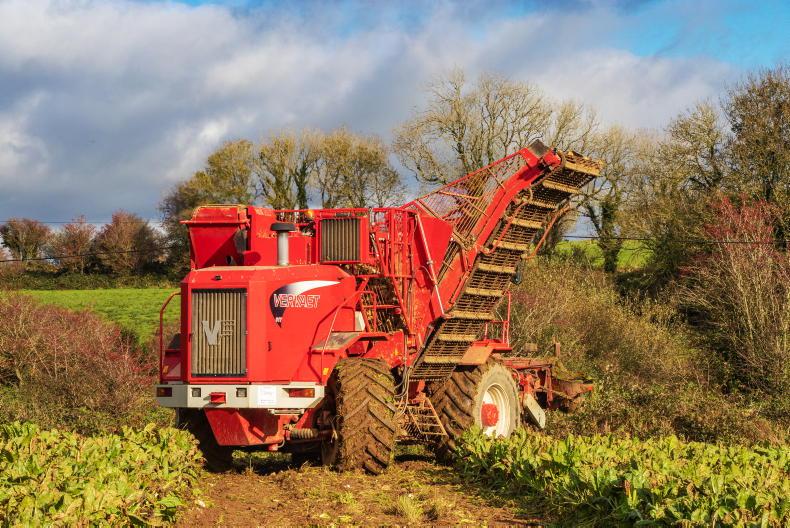
\ Gearoid Holland
Why a self-propelled?
Up to this year, the Crowleys were harvesting beet using two twin-row Armer Salmon harvesters, one of which was a heavy duty TR2000. In May, Kieran sourced a very tidy 2012 Vervaet 617 six-row harvester from a retiring tillage farmer near Lincolnshire in England. Although not that common in Ireland, the 617 is one of the most popular beet harvesters in the UK.
Kieran said: “I had been thinking of moving to a self-propelled machine for a number of years. We pull two-thirds of our beet after Christmas, which coincides with a higher demand to feed freshly calved cows.
“Conditions are often worse at this time of the year and the leaves tend to die off which makes it difficult to lift the beet with Armer Salmon machines. There were days I sent two lads out working and they might get very little harvested, spending hours adjusting machines to suit varying conditions.
“All of these adjustments are easily made from the cab with a modern SP machine, so there is little time lost.
“The sheer output capability of a SP machine meant there was far less time to be spent in the field. We often worked in the fields until 12pm or 1am at night with the trailed machines, whereas now we are home by 8pm with far more beet harvested. We have our lives back!
“Our daily output has increased from four to eight acres per day up to the present 25 acres per day. The improved efficiency and better quality of life meant the machine made it well worth the investment.” 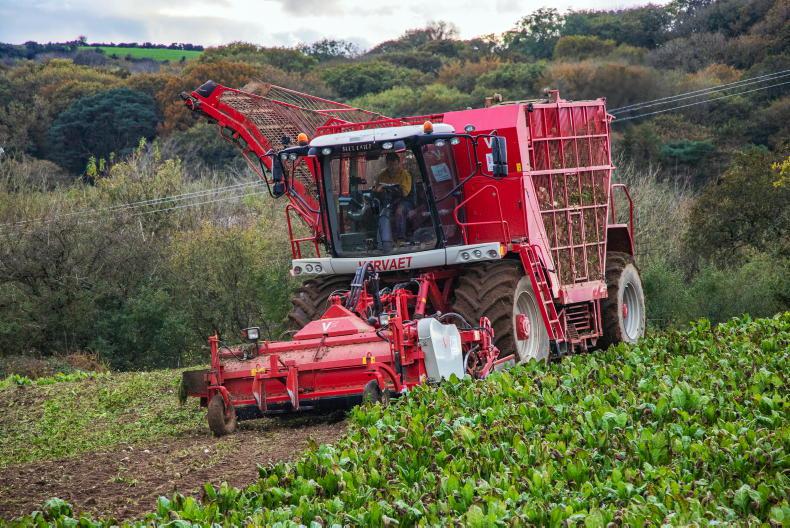
\ Gearoid Holland
How does it work?
Starting at the very front, a flail topper chops the leaves off the beet. An auger and spreader distribute these chopped leaves to the left-hand side of the machine. Two support wheels determine the cutting height of the flails.
Next up are the scalpers, which cut the heads off the beet. The depth is controlled hydraulically and adjusted from the cab when the scalpers are in use. However, the flail topper generally does a good enough job, meaning the scalpers are rarely used.
Vibrating shares are used to dig the beet out of the ground. The shares rotate in circular motions and run at 700rpm, meaning each creates 23 lifting motions per second. A flicker then feeds the beet on to the lifting turbines.
This machine has one turbine to each row, six in total. The lifting turbines pass the beet on to and through six cleaning turbines. The beet is then transferred into the ring trace elevator which rotates clockwise, dropping the beet into the hopper.
All machine adjustments can be made from the cab, including the working depth and hydraulic alteration of the rows. 
\ Gearoid Holland
Unloading
The machine has a 17t hopper, and is capable of unloading via a conveyer while on the go. Kieran noted that as the SP harvester is higher, it has the ability to unload over the top crate of his silage trailers, whereas his previous trailed harvesters couldn’t. This means he can now fit 20/22t in the 22ft trailers, as opposed top 12-14t when using the trailed harvester.
Likewise, when working in small fields, he can now unload directly over the hedge into his rigid lorry or silage trailer, meaning the machines don’t bring dirt on to the roads and help reduce ground compaction. It offers an unloading time of 35 seconds, up to a height of four metres. 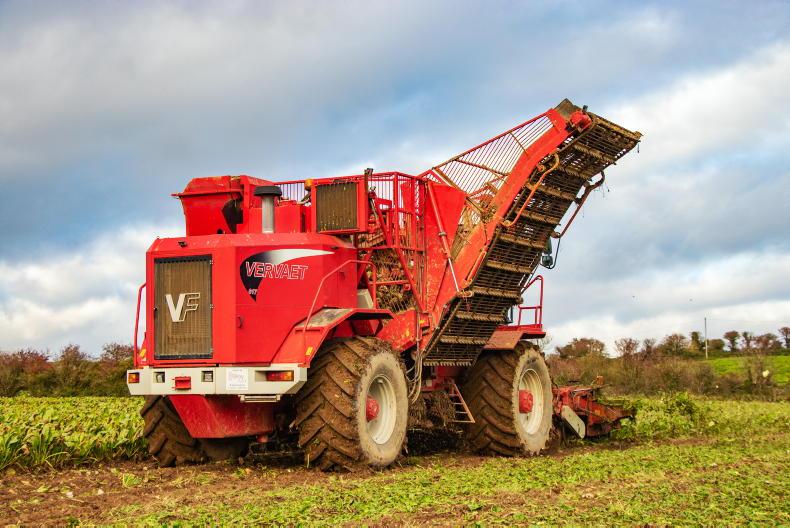
\ Gearoid Holland
Traction
Although working on mostly good land, Kieran said they work on quite a bit of hilly ground, with the latter being one factor holding him back on making such a move sooner. Despite this, he said he was seriously impressed with the machine’s traction capabilities, both on hills and in lower-lying fields.
“I spent two days with a contractor in Co Armagh last year and I saw the same machine working in conditions I know the trailed harvester wouldn’t manage. Similarly, this year, we’ve worked the machine in areas where tractors and trailers wouldn’t stay afloat. For a machine that weighs in at 20t empty, it has serious traction capabilities.
“The offset steering is also a great job, and it helps reduce ground compaction. The offset position means the harvester has a larger footprint, thus spreading the weight.
“The fact it harvests six rows instead of two rows (as with the previous harvester), also means there is less driving up and down the field.”
The harvester is running on large flotation tyres, with two 850/60 R38s on the front and two 800/60 R38s on the back. 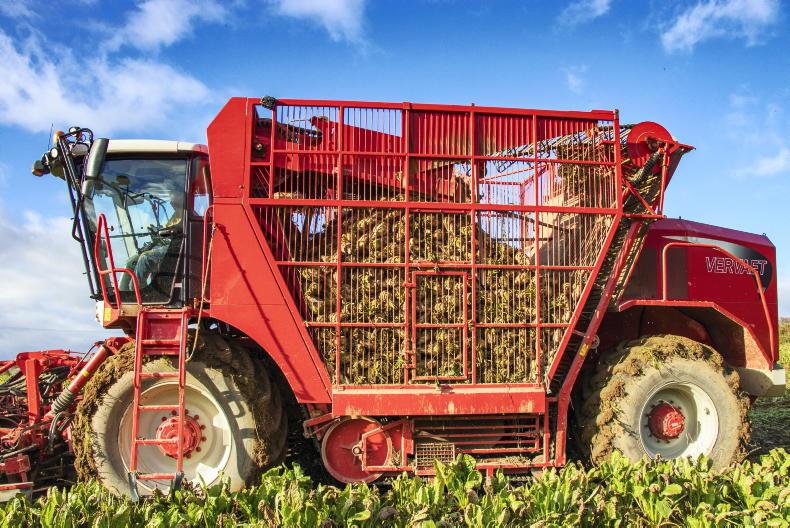
\ Gearoid Holland
Engine and transmission
The Dutch-built harvester is powered by a 12.9l DAF engine that churns out 465hp. The machine is hydrostatically driven, featuring a field mode and road mode. In field mode, the machine has a typical working speed of 6-7km/h, comparable to the Crowley’s previous trailed Armer Salmon harvesters.
However, it will hit a speed of up to 40km/h in road mode. Equipped with a 970l diesel tank, the machine works at around 1,400rpm, while fuel consumption equates to around one tank to harvest 60 acres, or two-and-a-half days’ work.
The machine has four-wheel steering, and can work in an offset position. Once harvesting, the machine is automatically steered, following the rows of beet. A steering guide on the topper uses electric sensors and steers the front of the machine. Meanwhile, a sensor on the shares steers the rear wheels.
Vervaet sources the cab from Claas, the same cab is used in the Jaguar self-propelled foragers.

\ Gearoid Holland
“We are more than happy with the harvester; it has performed far better than we had expected. We have over 3,500t of beet put through it and it hasn’t missed a beat. My brother Niall operates the machine. It took a good day or two to get the hang of the control layout, but we have a good grasp of it now. In the field, the machine has serious traction and throughput capabilities.
“Moving from pulling beet by the leaf to digging it has meant we are now bringing in some stones, but the wash plant is separating them all at its ease. The SP brings a lot of advantages over the trailed machine, such as the way we can now split big fields and harvest sections, without having to harvest round and round in the same direction”.
“It runs at very low rpm, but the 465hp engine likes its diesel. In fairness, the machine has transformed our operation and helped improve our lifestyle. We can now get through a serious amount of work in a short space of time. After wet weather, we can allow the ground time to dry, without falling behind on work.
“The only regret I have is that I didn’t buy the machine several years ago,” laughed Kieran.
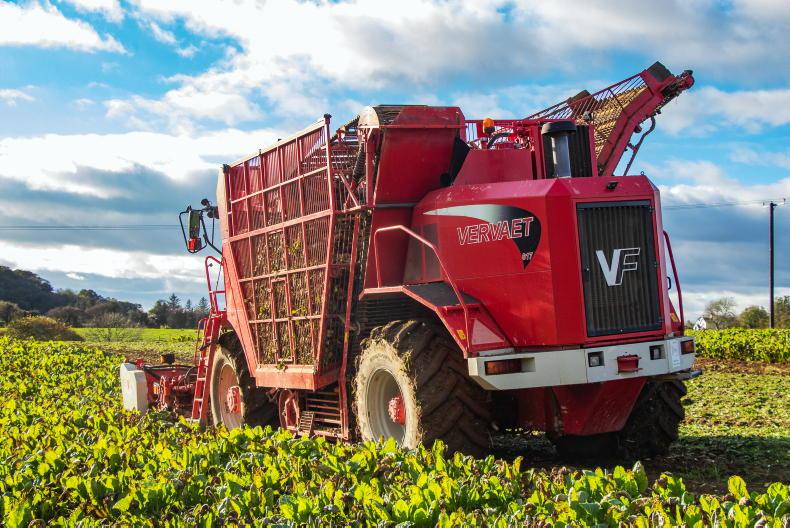
\ Gearoid Holland
Engine: 12.9l DAF.
Horsepower: 465hp.
Working width: three metres (six rows).
Transmission: continuous four-wheel-drive hydrostatic.
Fuel tank capacity: 970 litres.
Output: two and a half acres/hour (at 32t/acre washed).
Year of manufacture: 2012.

\ Gearoid Holland
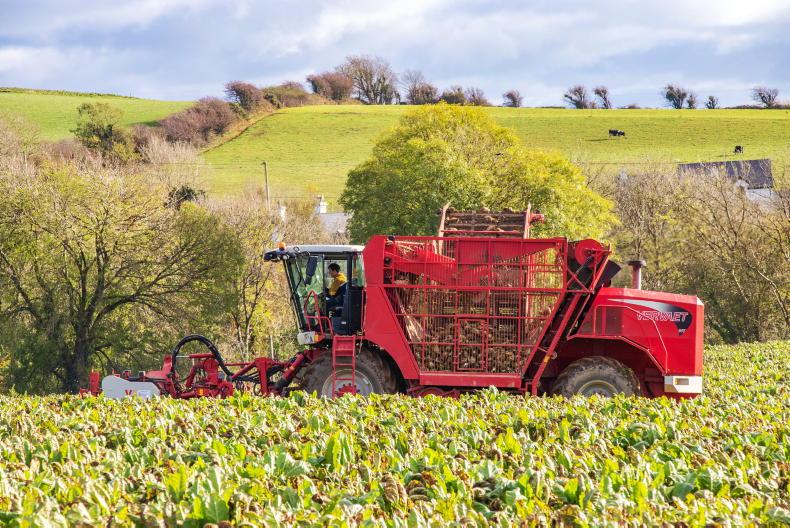
\ Gearoid Holland

\ Gearoid Holland
Twenty-six years after first setting out harvesting beet on hire with a single-row Armer Salmon harvester, Kieran Crowley made the decision to move to a self-propelled machine this year.
Located in one of Ireland’s strongest beet growing regions, he had been playing with the idea for several years now. Growing corn and beet on the home farm, Kieran also runs a contracting business.
“I’ve been growing beet all my life. My father was at it before me too. We are currently harvesting 500 acres annually, with almost half of that being for ourselves. We are situated near Ballinadee, between Bandon and Kinsale in Co Cork. It’s estimated there is in the region of 1,000 acres of beet being grown in our parish alone,” he said. 
\ Gearoid Holland
Previous harvesters
Pre-1995, the Crowleys were growing 40 acres of beet annually for the then-vibrant sugar beet industry. This was being harvested with a single-row Armer Salmon harvester. In 1995, the family decided to offer beet harvesting on hire as part of their contracting operation, purchasing a fresh single-row Armer Salmon carousel-type harvester. Over the following decade, their harvesters were upgraded as the acres increased.
Kieran said: “When the beet factories closed in the mid 2000s, we were growing 100 acres annually ourselves and harvesting 350-400 acres on hire. All this was being harvested with a twin-row Armer Salmon machine. We thought the closure of the industry would break us. Our area harvested the following year dropped to just 70/80 acres. It was a massive hit at the time.
“Since then, the acres grown around us have increased steadily. Six or seven years ago we began washing the beet, and chopping it for some customers. This was a great boost and further increased our customer base which extends to a 50km radius. Last year, we harvested 400 acres, and are set to harvest 500 acres this year, all of which is grown within four miles of us.” 
\ Gearoid Holland
Why a self-propelled?
Up to this year, the Crowleys were harvesting beet using two twin-row Armer Salmon harvesters, one of which was a heavy duty TR2000. In May, Kieran sourced a very tidy 2012 Vervaet 617 six-row harvester from a retiring tillage farmer near Lincolnshire in England. Although not that common in Ireland, the 617 is one of the most popular beet harvesters in the UK.
Kieran said: “I had been thinking of moving to a self-propelled machine for a number of years. We pull two-thirds of our beet after Christmas, which coincides with a higher demand to feed freshly calved cows.
“Conditions are often worse at this time of the year and the leaves tend to die off which makes it difficult to lift the beet with Armer Salmon machines. There were days I sent two lads out working and they might get very little harvested, spending hours adjusting machines to suit varying conditions.
“All of these adjustments are easily made from the cab with a modern SP machine, so there is little time lost.
“The sheer output capability of a SP machine meant there was far less time to be spent in the field. We often worked in the fields until 12pm or 1am at night with the trailed machines, whereas now we are home by 8pm with far more beet harvested. We have our lives back!
“Our daily output has increased from four to eight acres per day up to the present 25 acres per day. The improved efficiency and better quality of life meant the machine made it well worth the investment.” 
\ Gearoid Holland
How does it work?
Starting at the very front, a flail topper chops the leaves off the beet. An auger and spreader distribute these chopped leaves to the left-hand side of the machine. Two support wheels determine the cutting height of the flails.
Next up are the scalpers, which cut the heads off the beet. The depth is controlled hydraulically and adjusted from the cab when the scalpers are in use. However, the flail topper generally does a good enough job, meaning the scalpers are rarely used.
Vibrating shares are used to dig the beet out of the ground. The shares rotate in circular motions and run at 700rpm, meaning each creates 23 lifting motions per second. A flicker then feeds the beet on to the lifting turbines.
This machine has one turbine to each row, six in total. The lifting turbines pass the beet on to and through six cleaning turbines. The beet is then transferred into the ring trace elevator which rotates clockwise, dropping the beet into the hopper.
All machine adjustments can be made from the cab, including the working depth and hydraulic alteration of the rows. 
\ Gearoid Holland
Unloading
The machine has a 17t hopper, and is capable of unloading via a conveyer while on the go. Kieran noted that as the SP harvester is higher, it has the ability to unload over the top crate of his silage trailers, whereas his previous trailed harvesters couldn’t. This means he can now fit 20/22t in the 22ft trailers, as opposed top 12-14t when using the trailed harvester.
Likewise, when working in small fields, he can now unload directly over the hedge into his rigid lorry or silage trailer, meaning the machines don’t bring dirt on to the roads and help reduce ground compaction. It offers an unloading time of 35 seconds, up to a height of four metres. 
\ Gearoid Holland
Traction
Although working on mostly good land, Kieran said they work on quite a bit of hilly ground, with the latter being one factor holding him back on making such a move sooner. Despite this, he said he was seriously impressed with the machine’s traction capabilities, both on hills and in lower-lying fields.
“I spent two days with a contractor in Co Armagh last year and I saw the same machine working in conditions I know the trailed harvester wouldn’t manage. Similarly, this year, we’ve worked the machine in areas where tractors and trailers wouldn’t stay afloat. For a machine that weighs in at 20t empty, it has serious traction capabilities.
“The offset steering is also a great job, and it helps reduce ground compaction. The offset position means the harvester has a larger footprint, thus spreading the weight.
“The fact it harvests six rows instead of two rows (as with the previous harvester), also means there is less driving up and down the field.”
The harvester is running on large flotation tyres, with two 850/60 R38s on the front and two 800/60 R38s on the back. 
\ Gearoid Holland
Engine and transmission
The Dutch-built harvester is powered by a 12.9l DAF engine that churns out 465hp. The machine is hydrostatically driven, featuring a field mode and road mode. In field mode, the machine has a typical working speed of 6-7km/h, comparable to the Crowley’s previous trailed Armer Salmon harvesters.
However, it will hit a speed of up to 40km/h in road mode. Equipped with a 970l diesel tank, the machine works at around 1,400rpm, while fuel consumption equates to around one tank to harvest 60 acres, or two-and-a-half days’ work.
The machine has four-wheel steering, and can work in an offset position. Once harvesting, the machine is automatically steered, following the rows of beet. A steering guide on the topper uses electric sensors and steers the front of the machine. Meanwhile, a sensor on the shares steers the rear wheels.
Vervaet sources the cab from Claas, the same cab is used in the Jaguar self-propelled foragers.

\ Gearoid Holland
“We are more than happy with the harvester; it has performed far better than we had expected. We have over 3,500t of beet put through it and it hasn’t missed a beat. My brother Niall operates the machine. It took a good day or two to get the hang of the control layout, but we have a good grasp of it now. In the field, the machine has serious traction and throughput capabilities.
“Moving from pulling beet by the leaf to digging it has meant we are now bringing in some stones, but the wash plant is separating them all at its ease. The SP brings a lot of advantages over the trailed machine, such as the way we can now split big fields and harvest sections, without having to harvest round and round in the same direction”.
“It runs at very low rpm, but the 465hp engine likes its diesel. In fairness, the machine has transformed our operation and helped improve our lifestyle. We can now get through a serious amount of work in a short space of time. After wet weather, we can allow the ground time to dry, without falling behind on work.
“The only regret I have is that I didn’t buy the machine several years ago,” laughed Kieran.

\ Gearoid Holland
Engine: 12.9l DAF.
Horsepower: 465hp.
Working width: three metres (six rows).
Transmission: continuous four-wheel-drive hydrostatic.
Fuel tank capacity: 970 litres.
Output: two and a half acres/hour (at 32t/acre washed).
Year of manufacture: 2012.

\ Gearoid Holland

\ Gearoid Holland

\ Gearoid Holland














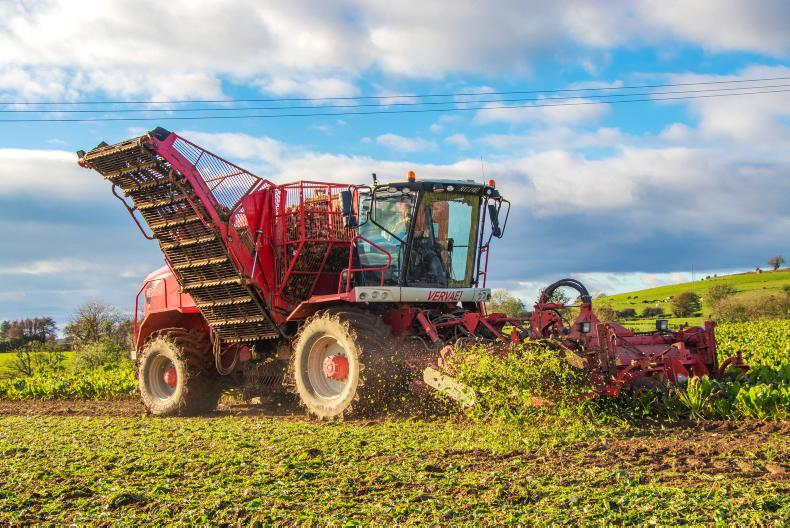

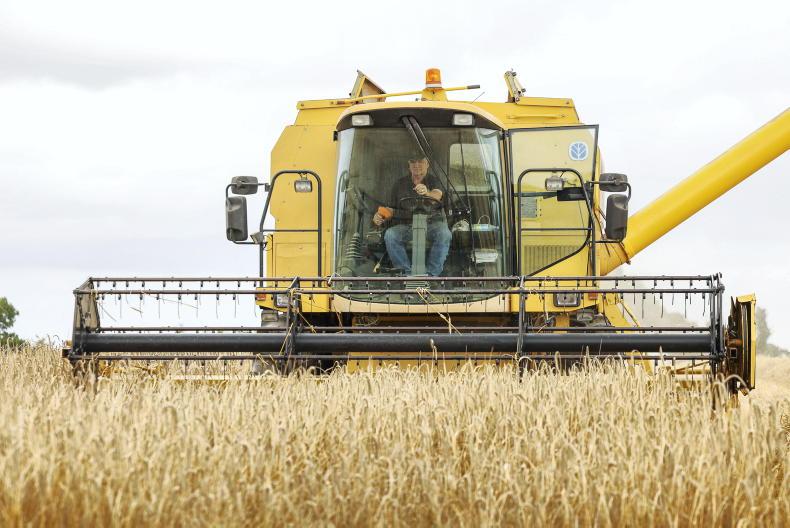

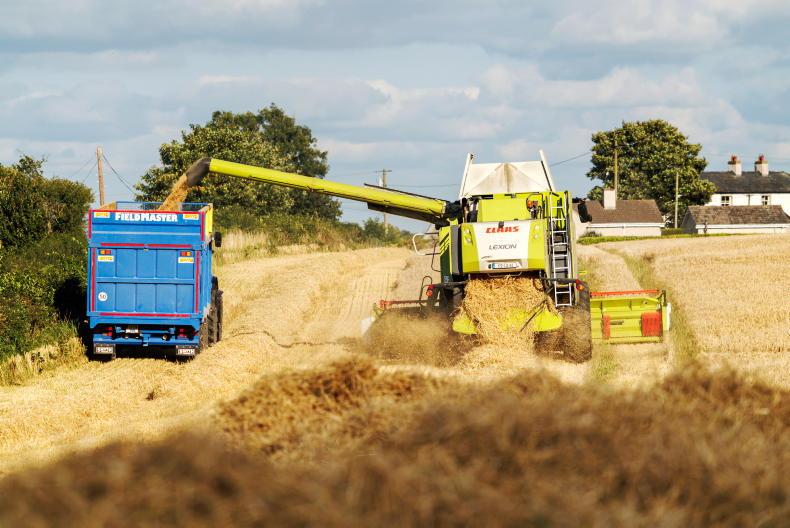
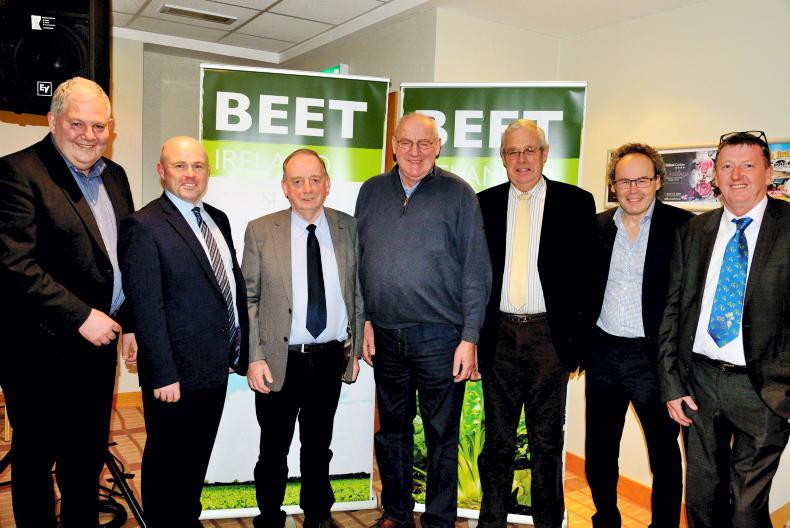
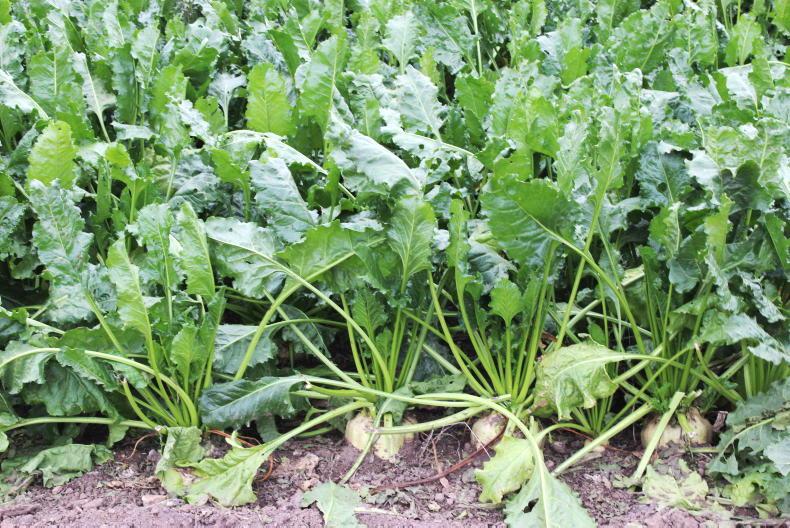
SHARING OPTIONS